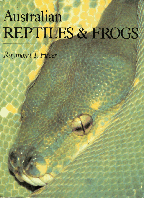 BANDY BANDY Vermicella annulata (Gray, 1841)
BANDY BANDY Vermicella annulata (Gray, 1841)
Found in about 80% of mainland Australia, except for the south-west, far north west, and far south east, the Bandy Bandy averages 60 cm although specimens of 80 cm are known. Since the original publication of this book, the Bandy Bandy, as commonly known has been split into several species.
The scalation is smooth with 15 mid body rows, 180-230 ventrals, divided anal, and 14-28 divided subcaudals.
The Bandy Bandy is found in all types of habitat, from rainforests to deserts. It is usually found during the day under cover or on mild nights moving around above the ground surface. The preferred night surface activity temperature appears to be lower than that of most other snakes, and more in line with Blind Snakes (Typhlopidae), its' principal food.
This snake consumes very little food over long periods due to its' unusually slow metabolic rate.
When caught this snake is usually nervous often knotting itself around one's hand in a manner not unlike that of Blind Snakes (Typhlopidae). If suddenly alarmed this snake may flatten its' body and elevate parts in loops in a bluff display. This display position can be maintained for some time.
This snake produces 4-5 eggs in the warmer months. Hatchlings measure 17 cm.
The above was from the book Australian Reptiles and Frogs by Raymond Hoser and now available on a fantastic CD-Rom along with a vast amount of other information, papers and the like on reptiles, frogs and other wildlife.